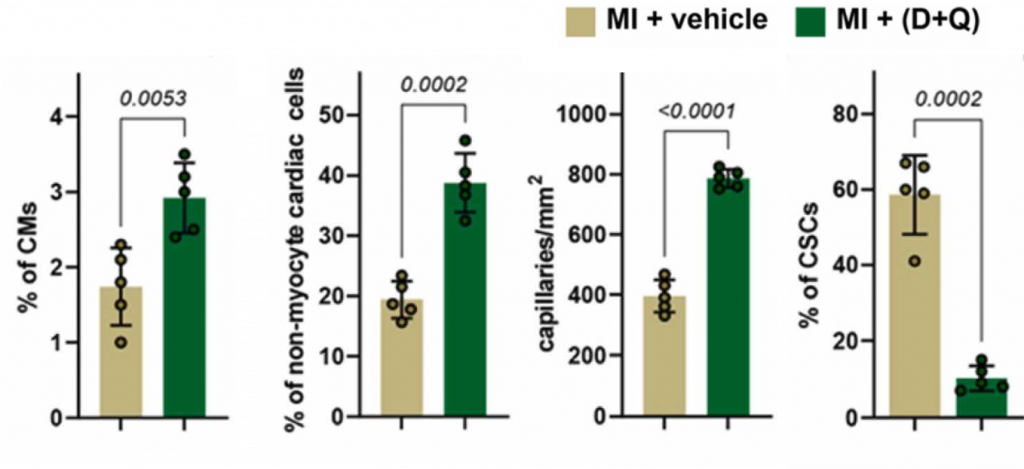Key Points:
- Treating mice with D + Q largely restores the heart’s blood-pumping function after myocardial infarction.
- D + Q eliminates senescent cardiac stem cells and increases the formation of new cardiac cells and blood vessels surrounding damaged tissue.
Nearly 80% of all deaths linked to cardiovascular disease are among elderly individuals, as aging seems to be particularly harsh on the heart. Accordingly, advanced age increases the risk of cardiovascular disease — encompassing atherosclerosis, hypertension, and myocardial infarction — which leads to heart failure. In part, this is due to a decline in cardiac tissue regeneration following damage. Now, scientists from Magna Graecia University in Italy may have found a way to rejuvenate the aging heart by restoring cardiac regenerative capacity.
As reported in Mechanisms of Ageing and Development, Salerno and colleagues show that clearing senescent cells with D + Q improves cardiac function following myocardial infarction in aged mice. They go on to show that D + Q removes senescent cardiac stem cells, which are required to generate new cardiac cells. Indeed, D + Q is shown to increase the formation of new cardiac cells while also increasing blood vessel growth. The findings suggest that senolytics can restore the regenerative capacity of the aging heart, which may have implications for preventing heart failure.
Senolytics Improve Heart Function and Regenerative Capacity
Myocardial infarction (MI) is caused by a lack of blood flow to the heart, leading to cardiac tissue damage. To model MI, Salerno and colleagues tied off the largest artery supplying blood to the heart in mice. The resulting cardiac tissue damage led to a reduction in the heart’s blood pumping function. This included a reduction in the ejection fraction (EF) — the volume of blood pumped out of the heart with each beat. By treating the mice with three consecutive injections of 5 mg/kg of Dasatinib and 50 mg/kg Quercetin (D + Q) every week for four weeks after MI, the researchers largely restored cardiac function, including a significant improvement in EF.

Like all of our cells, our heart cells inevitably encounter DNA damage and oxidative stress — damage caused to cells by excessive reactive oxygen species (ROS). This kind of cellular damage triggers cells into a senescent (dormant) state. Senescent cells accumulate with age and contribute to chronic low-grade inflammation that accelerates cardiovascular aging. Senolytics like D + Q selectively eliminate senescent cells by activating programmed cell death.
Following MI, Salerno and colleagues found that D + Q reduced cardiac cell DNA damage and ROS production while removing senescent cells to reach levels similar to young mice. D + Q also decreased senescent stem cells and increased the formation of new cardiac cells at the border of the damaged area (infarct). Furthermore, D + Q treatment doubled blood vessel growth (angiogenesis). These findings demonstrate that eliminating senescent cells after MI leads to improved heart repair and regeneration.

Until now, the role of senescence in the aging heart had only been explored in male mice. Salerno and colleagues show for the first time in female mice that clearing senescent cells can restore age-related heart dysfunction.
Can Senolytics Prevent or Delay Heart Failure?
While the heart can regenerate, its capacity to do so is insufficient to counteract the damage induced by MI. This regenerative capacity is further reduced by the aging process. Therefore, senolytics can potentially be used therapeutically to promote heart regeneration and delay or prevent heart failure. Plant-based molecules called polyphenols have senolytic properties similar to D + Q. Berberine, and its derivative tetrahydroberberrubine both have been shown to reduce senescent cardiac cells and mitigate heart degeneration. Furthermore, resveratrol is associated with reducing senescent cardiac cells and improving heart function. Therefore, polyphenols like these and other senolytics like D + Q have promise in slowing down the aging process of the heart and perhaps preventing or delaying heart failure.